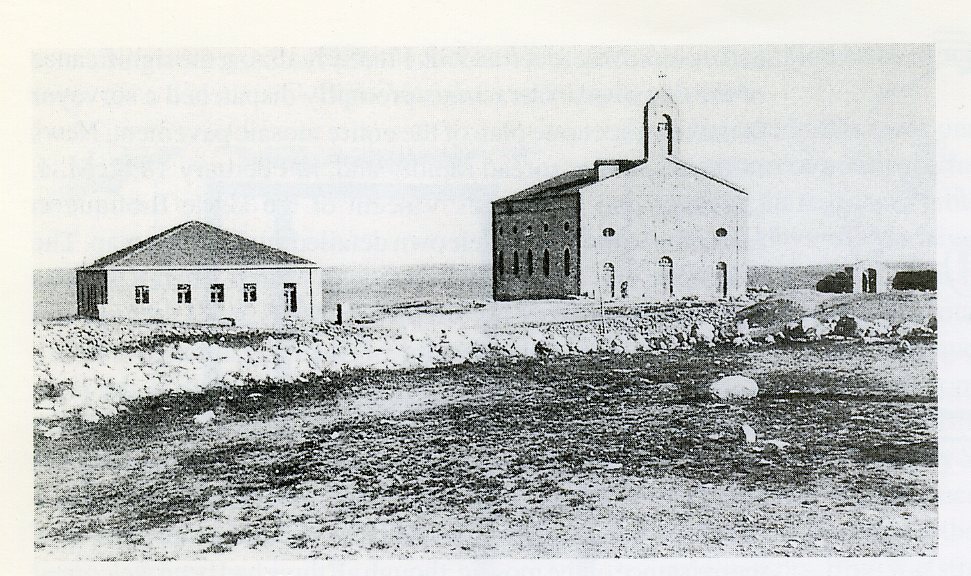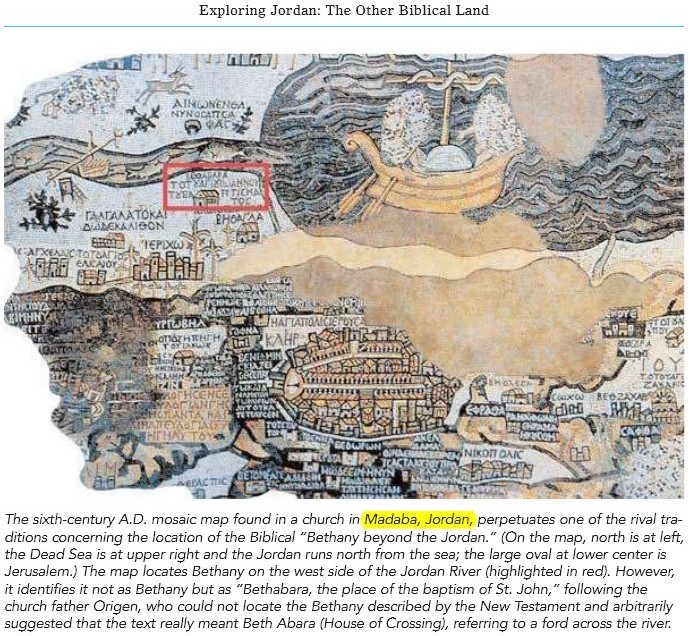|
Other Archaeological Sites / The Neolithic of the Levant (500 Page Book Online) Ancient Tell Mādabā in Jordan
The Madaba Plains Project: Forty Years of Archaeological Research into Jordan's Past "The year 2008 marks the 40th anniversary of Mabada Plains Project archaeological research in the Hashemite Kingdom of Jordan. The Madaba Plains Project is one of the longest-lived continuously running archaeological excavation projects in the Middle East. The project had its beginnings at Tall Hisban in the late sixties ... " Biblical Abstract: A town east of the Dead Sea and a few miles south of Heshbon. It was wrested from the Moabites by Sihon King of the Amorites (3); Insert:Sihon King of the Amorites drove them [Moabites] South of the river Arnon which is now the Wadi Mujib (Numbers 21:26-30 KJV in 9). and after the conquest of Palestine it was assigned together with the plain in which it lay to the tribe of Reuben. During the war of the Ammonites against David (reign circa 1010 to 970 BCE) the Syrian allies of the former encamped at Medeba, which seems at that time to have been under Ammonite control (3). Insert:David also vanquished an Ammonite and Aramean [Syrian] coalition near Madaba (I Chronicles 19:7) [5]. Insert: Joab found his army in between the Arameans and Ammonites which meant he might have to fight on two fronts. The Ammonites placed themselves before the city, presumably a reference to their capital Rabbah. The Arameans on the other hand gathered in the open country which is believed to have been South and a little West of Rabbah near the city of Medeba [again see I Chronicles 19:7 in 10]. Insert: His victory was short-lived however as in the mid-ninth century BCE the Moabite King Mesha freed the city from the control of the Israelites (2 Kings 3) [5]. Later it was seized by the Moabites again; for according to the Moabite Stone (line 8) ... "Omri (reign circa 884 BC – 873 BC) annexed [all the land] of Medeba and Israel occupied it; his days and half his son's days --- forty years". This statement is confirmed by Isaiah 15:2 which mentions Medeba as a city of Moab under whose control it remained until the Moabites were driven south of the Arnon River [again] by Jeroboam II (reign 786–746 BC) [3]. Note: The Moabites as a people were ultimately destroyed though the region was still often referred to as the country of Moab. By the time of the Inter-Testament Period (beginning circa 420 BC) an unrelated Semitic tribe occupied Medeba (11). In Maccabaean times the Ammonites reoccupied Madaba circa 165 BCE but it was taken from them by [the Judaean High Priest and Prince of the Hasmonean Dynasty] Hyrcanus I around 110 BC (5) He [Hyrcanus] marched against the fort of Madaba on the banks of the Jordan which had always been hostile to the Hasmoneans and conquered it after a six months' siege (8). His son Hyrcanus II later gave the city to the Nabateans in exchange for their help in recovering Jerusalem from Aristobulus II. Near the beginning of the second century CE Trajan ousted the Nabateans from Madaba and the city gradually became a Roman provincial town with the usual colonnaded streets and impressive public buildings (5). During its rule by the Roman and Byzantine empires from the 2nd to the 7th centuries the city formed part of the Provincia Arabia set up by the Roman Emperor Trajan to replace the Nabataean Kingdom of Petra. The first evidence for a Christian community in the city is found in 451 (4). This is revealed in the Acts of the Council of Chalcedon (AD 451) where the Metropolitan Archbishop Constantine of Bostra signed the conciliar decisions in the absence of a certain Gaianus the "Bishop of the Madabites" (Page 4 6). After the Persian invasion of 614 CE and a devastating earthquake in the year 746 the town was gradually abandoned. Madaba then lay virtually untouched until it was resettled in the late 19th century by Christians from Karak (5). The ruins or rather the whole neighborhood [area] was ceded by the Turkish government in 1880 to Christian Bedouins from Karak and three tribes of them now live in the new town; the Azaizat, the Ma’a‘iya and the Karadsché. All of them belong to the Greek Catholic church except about thirty Roman Catholic families of the Azaizat and these are the leaders of the whole (7).
Excerpts and Definitions and Addendums: ... In the modern Middle East with its long history of urbanism the consequences of urban continuity present a daunting challenge to archaeological research. The city of Mādabā located 30 kilometers southwest of Amman amidst the fertile rolling plains of the Central Jordan Plateau is a case in point. Continuing an urban tradition of some 5,000 years the modern town engulfs the ancient settlement, preserved in the form of a large low-lying tell and acropolis (approximately 16 hectares in area at the base and 9 hectares at the summit) that still forms a visible rise in the town center. Yet Mādabā's historical prominence prevents us from ignoring its role in the rich and eventful history of Highland Central Jordan. The ancient urban core of Mādabā therefore presents both a challenge and an opportunity to explore the complex remains of a site at the center of the cultural and political life of this region (1). The history of early exploration in Madaba is a long and colorful one. It begins with the German explorer Ulrich Seetzen who visited the site in 1806 and extends through a succession of travelers, adventure seekers and scholars who made numerous discoveries culminating with the announced uncovering of the famous Madaba Mosaic Map of Palestine in 1896 (ibid). The modern archaeological exploration of Madaba commenced in the 1930s with Nelson Glueck's monumental survey of Eastern Palestine and the start of the Franciscan excavations at Siyagha-Mount Nebo. In 1948 workers digging the foundations for a new house stumbled upon a Late Bronze-Early Iron Age tomb, furnishing the first archaeological evidence of pre-Roman occupation at the site. The ensuing decades witnessed a steady flow of salvage excavations and restoration projects conducted on behalf of the Jordanian Department of Antiquities and for the most part concentrated in the lower city of classical times. The Tell Madaba Archaeological Project (TMAP) was inaugurated in 1995 with the express purpose of assembling an "urban" sample as part of a larger ongoing regional research effort (ibid). Reconstructing the process by which the Early Iron Age communities in the highlands of central Jordan coalesced into the culturally and politically defined polities referred to in later historical sources is not an easy undertaking. Scholars have traditionally interpreted the textual evidence to suggest that the region experienced wide spread land-use and settlement during this period (circa 1200-900 BCE) and witnessed the emergence of the territorial states of Ammon and Moab. Contrastingly syntheses of the archaeological record have generally characterized this period as one of limited sedentary activity marked by a gradual process of consolidation in which loosely organized regional communities became more integrated through expanding alliances and kinship networks. According to this perspective state formation and flourishing urban development occurred in the central highlands only much later during the era of Assyria and Babylonian domination (2). However this prevailing archaeological view has suffered from a critical lack of detailed material cultural sequences or "local histories" at the key highland sites occupied during the period. The results of recent excavations on the west slope of the upper mound at Tall Mādabā offer an opportunity to correct this shortcoming for the Mādabā Plain Region. The documentary evidence suggests that Mādabā had emerged as an important regional centre well before the mid-ninth-century of Mesha the Dibonite and his acknowledgement that much of the central highland plateau belonged to the land of Medeba (ibid). According to biblical tradition the Mādabā Plain (the biblical Mishor) was initially allotted to the tribe of Reuben but later became part of the territory of the [tribe] Gadites (Joshua 21:38-39); note also Mesha's claim [line 10] that the 'men of Gad' had always lived there.
(1) Tell Mādabā Archaeological Project (TMAP)
(2) Studies on Iron Age Moab and Neighbouring Areas by Timothy Harrison (3) MEDEBA (1906 Jewish Encyclopedia) (4) Madaba (Wikipedia) (5) Madaba (The Hashemite Kingdom of Jordan) (6) Madaba: Cultural Heritage Timothy Harrison et al (1996) American Center of Oriental Research (7) The Mâdaba Map by Caspar René Gregory in The Biblical World Volume 12 (1898) (8) HYRCANUS, JOHN (JOHANAN) I (1906 Jewish Encyclopedia) (9) Moab (Fausset's Bible Dictionary) 1970 (10) DAVID’S WAR WITH THE AMMONITES AND ARAMEANS (The Disciplined Order of Christ) (11) Medeba (Madaba) (Lion Tracks Ministries)
|


